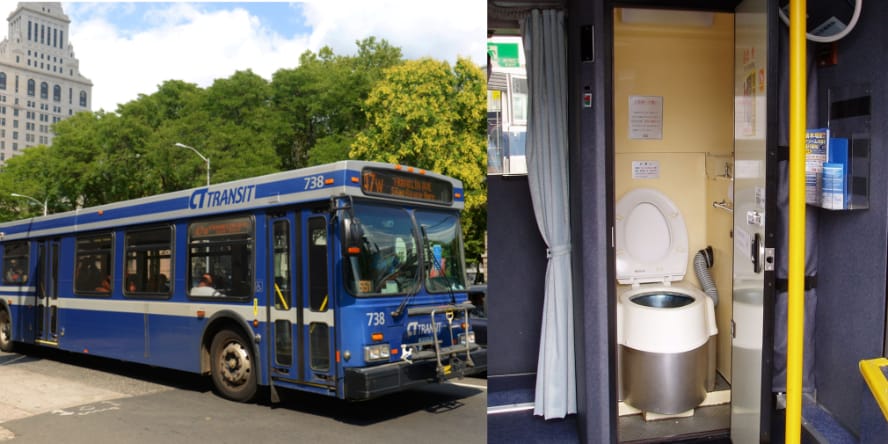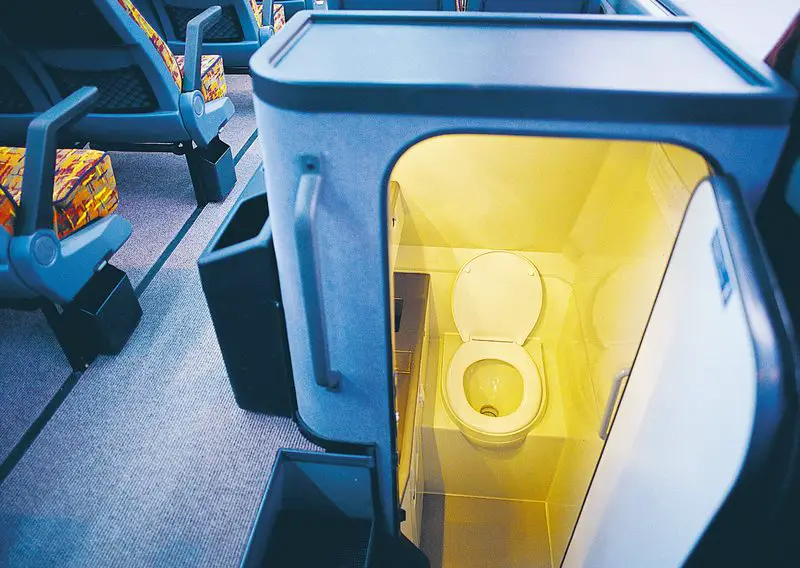
When you’re a little short of cash, but have to take a long journey, a bus trip is usually the cheapest option. I doubt it’s most people’s cup of tea, but sometimes we need to put up with fewer comforts for the sake of our pockets.
So, you’re a few hours into your journey, and your body orders a bathroom break at an inconvenient time. Do buses have bathrooms, and how do they work?
Charter and tour buses usually have bathrooms on board for the convenience of those traveling long distances. Bus toilets are equipped with holding tanks to contain human waste until they can be emptied. A blue formaldehyde hygiene product in the tank masks any unpleasant odors.
If you’re going on a long bus trip across the country, you will appreciate the added amenity of a bathroom on board the coach.
After all, some public restrooms at truck stops and rest areas can be scary! Plus, nature’s call is not always attuned to scheduled bus stops!
Why Do Only Some Buses Have Bathrooms?
School buses and city transit buses don’t have on-board bathrooms. They don’t need them as most people will cope with their needs until they reach their destinations.
Long trips are another story altogether, which is why charter and tour buses (coaches) have built-in bathrooms.
Bathrooms on buses are a luxury as well as a necessity. These buses run on schedules and only stop at specified places. A driver can’t make multiple stops every time one or more of the fifty-odd passengers need a bathroom break.
Toilets on buses are much like the portable ones found at public events. One can’t help wondering how they work and where the waste goes when a passenger returns to their seats! No, the waste does not flow out onto the road while the bus is driving!
Bus toilets were designed mainly for liquid waste and small solids (child-sized). They can’t accommodate large deposits because there is no vacuum to pull the solids down, as in regular toilets.
Two Types Of Bus Toilets
You will find one of two types of toilets in a bus’ bathroom:
One has a flap inside the bowl that prevents you from seeing the contents of the holding tank.
The other is sans flap, allowing a clear view into the tank. I know which one I would prefer!
The toilet with the flap is equipped with a handle to flush after use. When you flush the toilet, the blue formaldehyde product flows into the bowl. The flap opens, and the waste is washed into the holding tank.
The toilet without the flap does not require flushing and doesn’t have a handle. Everything drops straight into the holding tank when a passenger uses the bathroom.
How The Bus Toilets Work

Most coach bathrooms have a dual tank system. There is a holding tank filled with water directly below the mobile throne. It has a blue formaldehyde tablet added to it, which creates the blue fluid you would have seen in a porta potty.
The blue liquid deodorizes and disinfects the toilet. It helps to control odors and break down the solids in the holding tank.
Let’s face it, the bathroom on a bus is not very big, so it’s essential to get rid of odors before the next passenger uses it. There is usually a vent that helps control the delightful bathroom fragrances. It pulls the smells from the bathroom to outside the bus.
Between long trips or the bus being parked in the sun for hours while passengers explore the city, the bathroom could develop an unsavory odor! This is where the second tank saves the day.
The second tank sits beneath the first holding tank. The driver can empty the contents of the primary tank into the second tank and refill it with clean water and another formaldehyde tablet. The secondary tank gets sealed and prevents any foul odors from escaping into the bus. Thus, the throne room is clean and fresh, ready for use on the return trip.
But suppose the passengers overuse the toilet on the return trip. Then the driver will either have to declare it out of order and not allow further use or find an appropriate RV dumping station (appropriate name) to get rid of the waste.
Once the bus is back at its home base, a cleaning crew will dump the contents of both holding tanks and rinse them out. Next, they will refill them with water and add the blue tablets for a fresh start to the next bus journey.
Bathroom Policies
Different coach companies each have their rules about bathroom use on their buses. Some bus companies do not permit anything but liquids to pass into their onboard toilets.
Others ask their passengers to ask the driver to stop to use a public restroom, keeping the on-board bathroom solely for emergencies. Others have a free-for-all policy. I’m not sure how one enforces these rules!
Whichever policy a company has, it is essential that they warn the passengers of the worst-case scenario should the toilet be overused.
Buses usually stop every two hours at convenient places for passengers to use restrooms, so using the bathroom on the bus only for emergencies sounds like the better option.
A True Bus Bathroom Story
In 2004 a driver for the Dave Matthews Band’s entertainment coach decided it was a good idea to clean out the coach toilet over the Chicago River. He pulled onto the bridge, which had a grated surface, and dumped the toilet’s contents.
It was supposed to disappear unnoticed into the river. But just then, a riverboat packed with tourists passed under the bridge, and they were treated to a shower of human waste!
The driver was subsequently caught and sentenced appropriately. True story. Disgusting but true! Thankfully, such happenings are the exception to the rule.
Conclusion
When you’re on a long bus journey, the first prize would be to tune your bladder into the scheduled bus stops. But life is not always like that, so buses that travel long distances have on-board bathrooms.
They have dual holding tanks that hygienically manage the waste, restoring the restroom to showroom condition (or should it be throne room condition?) for the next passenger. Hopefully!
